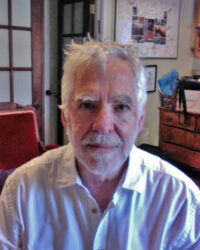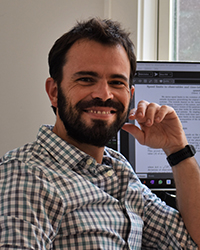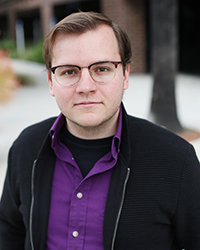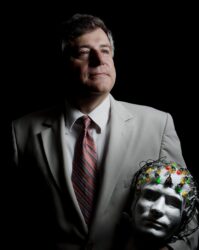 |
Christopher Bazinet
St. John’s University, New York |
The rapid evolution of the human brain has been described as a “special event” inconsistent with the gradual pace of evolution generally expected in conventional theory. Recent observations in comparative genomics and molecular/cell biology suggests a mechanism by which extraordinary complexity may rapidly evolve. |
 |
James Bradley
Calvin University (retired) |
Materialists often cite randomness in nature as evidence for a materialistic interpretation of the natural world. There is verbal sleight-of-hand happening here, though. The definition of randomness used by many materialists is that random means without purpose, design, or direction. However, when scientists use the word, their meaning is different – that a phenomenon is unpredictable or that it lacks a discernible pattern – the scientific definition does not exclude purpose. In fact, many natural systems use randomness in a way that appears goal-directed, perhaps even purposeful. This project aims to explore a number of such phenomena to see if, in fact, randomness in nature can seen as purposeful. |
 |
Zac Davis
Salk Institute for Biological Studies |
The decision making process must deal with uncertainty in both sensory evidence, and expected outcomes. This uncertainty can be manifest in variable activity across cortical populations that evaluate information and execute decisions. By recording the diverse neuronal activity across these cortical populations, we can ask whether variability is noise to be eliminated, or an adapted feature that helps us handle uncertainty to achieve our goals. |
 |
Luis Pedro Garcia-Pintos
University of Maryland |
If evolutionary processes have a goal, how fast can the goal be reached? What characteristics of a species or set of species enhance the evolutionary process? We identify diversity as a resource that allows for faster evolution and propose a way to quantify its influence on the speed. To explore this idea, we conceive of a model where the goal of the Homo genus is to achieve a higher level of consciousness. |
 |
Jake Gavenas
Chapman University |
Understanding the neural basis of human purposeful, goal-directed intentionality and decision making is key to understanding human agency. However, neuroscientific research faces challenges (1) from the brain’s highly parallel manner of information processing, (2) from spatiotemporal limits on neuroimaging technology, (3) and from severe limitations on causal interventions in human brains due to risk of harm. All three of these challenges can be alleviated by, instead of a human brain, working with artificial intelligence (AI) agents that make decisions in a human-like manner. I propose to leverage neuroscientific methods—such as machine-learning-based neural decoders, stimulation, and ablation—to reveal key facts about how goals and intentions emerge in and are represented by artificial agents, thereby learning about purpose, goals, and intentions in the human brain. |
 |
Frank Keil
Yale University |
Why does function intertwine so readily with mechanism in biological explanations while rarely doing so with the non-living natural world? The answer may lie not in human biases, but rather in causal-structural regularities unique to living things. These regularities range from the specifics of how function and mechanism interact within and across levels of explanation to the distinctive ways that energy and work occur in living things. I propose to explore boundary conditions between the living and non-living world, as well as human-made machines, to understand what makes certain forms of explanations for all living thing so compelling. |
 |
John Kounios
Drexel University |
When a person sets a goal, the brain’s cognitive control mechanisms narrow the scope of thought to focus on the goal and recruit relevant brain areas to plan how to achieve it. This can result in anxiety about potential failure to achieve the goal. When goal orientation is weak, cognitive control is relaxed and the scope of thought broadens to include wide-ranging, sometimes creative, thoughts, resulting in a positive mood. Alternating between weak and strong goal orientation allows for periods of both creative change and subsequent follow-through on these new thoughts. |
 |
Brian Lerch
University of North Carolina at Chapel Hill |
Species selection (the idea that differential speciation and extinction rates between species can drive changes in individual or species-level traits) has long been a controversial idea in evolutionary biology that is often linked to the misconception that evolution proceeds “for the good of the species.” Nevertheless, it has seen a recent resurgence in both theoretical support and evidence for its action has begun to accumulate in broad taxa. A major outstanding issue in theoretical work addressing species selection is to develop a mechanistic underpinning for its action, as changes to speciation and extinction rates are often left as a black box. I propose developing models of species selection that explicitly consider the way in which traits influence speciation and extinction rates. |
 |
Patrick McNamara
Northcentral University |
For goal directed motivational processes, the bridge principles connecting the subpersonal level with the personal level are embedded in REM sleep dreams. The dream is the most promising sub-personal level from which to identify the ways in which subpersonal processes, in this case dream images and symbolic forms, activate and engage the four fundamental, neurally specified motivational systems—the four Fs (feeding, fleeing, fighting and fornicating). The imagistic and symbolic language of the dream is intermediate between the brain-anatomical and personal levels, and it can be, and has been quantitatively modeled-though not sufficiently exploited to understand goal-directed motivational systems. We propose to use standard sleep neuroscience methods to identify the dream code that acts to set the organism’s goals and to guide and energize motivational systemsgold including gold-standard sleep diary/sleep EEG studies as well as selective REM vs NREM sleep deprivation paradigms to quantitate (using multilevel regression techniques) links between dream images/themes and subsequent daytime motivational behavior. |
 |
Stephanie Miller
University of Mississippi |
Although artificial intelligence (AI) produces behavior in line with goals, it remains limited in the ability to generalize, flexibly adapt, and generate creative responses. Cognitive-developmental models of conscious control proposes that goals-directed behavior differs in the degree that one is conscious of stimuli and subsequent behavior (Zelazo, 2004, 2015). Applying this perspective to AI may suggest that machines also execute different levels of goal-directed behavior, with most behavior operating at the lowest levels of consciousness (e.g., automatically executed programs in response to stimuli), with the potential to reach slightly higher recursive levels with advanced learning algorithms (e.g., programs that may build memory that can be coupled to label stimuli and guide behavior). From this perspective, it will be important to examine goal-directed behavior of machines in relation to humans across development, as humans are distinct in their intrinsic social motivations (e.g., Miller & Marcovitch, 2015) and developing levels consciousness—particularly self-consciousness likely critical to flexible innovative behavior. |









